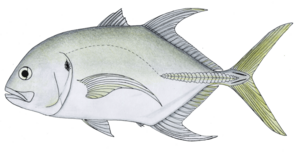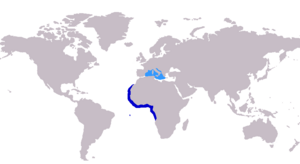Longfin crevalle jack facts for kids
Quick facts for kids Longfin crevalle jack |
|
|---|---|
 |
|
| Conservation status | |
| Scientific classification | |
 |
|
| Approximate range of the longfin crevalle jack. Current range indicated in dark blue, known historical range in light blue |
The longfin crevalle jack (Caranx fischeri) is a large ocean fish. It belongs to the family of jacks, called Carangidae. This fish lives in the warm waters of the eastern Atlantic Ocean. You can find it along the coast of Africa, from Mauritania down to Moçamedes in southern Angola. It used to live in the Mediterranean Sea too.
This fish stays close to the coast. It can even swim into estuaries (where rivers meet the sea), possibly to lay its eggs. The longfin crevalle jack looks a lot like the crevalle jack, Caranx hippos. But you can tell them apart by its longer dorsal and anal fin lobes. It can grow up to 127 cm long and weigh 20.9 kg. The longfin crevalle jack is a predator, meaning it hunts other animals. It mainly eats small fish.
People have been confused between this fish and the crevalle jack for a long time. So, we don't fully know how important each species is for fishing in Africa. However, combined catches in this area were between 2,233 and 10,054 tonnes per year from 1995 to 2004. Like its relatives, it's a strong gamefish that anglers like to catch. But its meat is not considered very good for eating.
Contents
About Its Name
The longfin crevalle jack is part of a group of fish called Caranx. These fish are also known as jacks or trevallies. The Caranx group is part of the bigger jack and horse mackerel family, Carangidae. This family is in the order Carangiformes.
This fish is very similar to the Caranx hippos and C. caninus. Scientists William Smith-Vaniz and Kent Carpenter officially described the longfin crevalle jack in 2007. They showed how it was different from C. hippos. The first official sample of the fish was collected in 1978 off Cameroon.
The fish is named after Dr. Walter Fischer. He was an official at the FAO (Food and Agriculture Organization). He started a program to identify different species. The common name 'longfin crevalle jack' comes from its longer fins. These fins help tell it apart from the regular crevalle jack.
What Does It Look Like?
The longfin crevalle jack is a big fish. Scientists measured one at 53 cm long. But anglers (people who fish with a rod and line) have caught much bigger ones. Some have been recorded up to 127 cm (about 4 feet) long!
Its body shape is similar to other large Caranx species. It is quite flat from side to side and shaped like a rectangle. Its back is more curved than its belly. The part of its body near the tail is quite thin.
The fish has two dorsal fins on its back. The first one has 8 stiff spines. The second has 1 spine and 21 to 24 soft rays. The dorsal and anal fins (on its belly) have slightly longer lobes (rounded parts). This is a key feature that helps tell it apart from the similar crevalle jack. The anal fin has 2 small spines before the main part, which has 1 spine and 17 to 19 soft rays.
The lateral line (a sensory line along its side) is curved near the head. This part has 50 to 73 scales. The straight part of the line has 0 to 16 scales and 24 to 41 scutes (hard, bony plates). The area on its chest, up to its pelvic fins, has no scales. There is a narrow band of scales between its chest and its pectoral fins (side fins). It has 20 to 25 gill rakers (filters in its gills) and 24 vertebrae (backbones).
The longfin crevalle jack is olive to greenish-blue on its back. Its belly is pale and white. The dorsal fin is dark brown to grey. The anal fin is brownish-yellow, turning white near the lobe. Its caudal fin (tail fin) is brown-yellow. The pelvic fins are white. This fish also has a dark spot on its gill cover and on the lower rays of its pectoral fin.
Where Does It Live?
The longfin crevalle jack lives in the warm waters of the eastern Atlantic Ocean. Its known range is from Mauritania in the north, south to at least Moçamedes in southern Angola. Old records show that Caranx fischeri used to be found in the Mediterranean Sea. However, no recent fish have been found there. This fish can travel long distances. One adult was found far out in the mid-Atlantic, near Ascension Island.
Based on the information we have, the longfin crevalle jack mostly lives inshore (close to the coast). But finding one near Ascension Island suggests it might also live in the open ocean (pelagically). When they are near the coast, they can be found around reefs. They also swim into estuarine environments, and sometimes even go far up into rivers.
Habitat and Behavior
We don't know all the details about the longfin crevalle jack's life. This is because it was only recently described, and people used to confuse it with C. hippos. However, we do know that all crevalle jack species are strong predators. They eat many kinds of small, schooling fish. These include herrings, other jacks, and porgies (fish from the Sparidae family). Smaller jacks, probably including C. fischeri, also eat invertebrates like shrimps and crabs. We don't know much about their breeding. They might lay their eggs in estuaries and rivers.
Relationship with Humans
Because of the confusion with C. hippos, we don't fully understand how much this fish contributes to fishing. The FAO recorded a combined catch of 2,233 to 10,054 t per year for C. hippos and C. fischeri from several African countries between 1995 and 2004. This shows that it is moderately important for fishing.
Like other crevalle jacks, this species is a strong gamefish. Anglers in West Africa like to catch it. They use lures or bait. However, the longfin crevalle jack is not considered a good table fish. Its meat is coarse and doesn't have much flavor. The IGFA (International Game Fish Association) world record for this fish is 28 kg (61 lb 12 oz). It was caught off the Loos Islands, Guinea by Daniel Gaillard in 2017. Before that, records were set in Angola.


